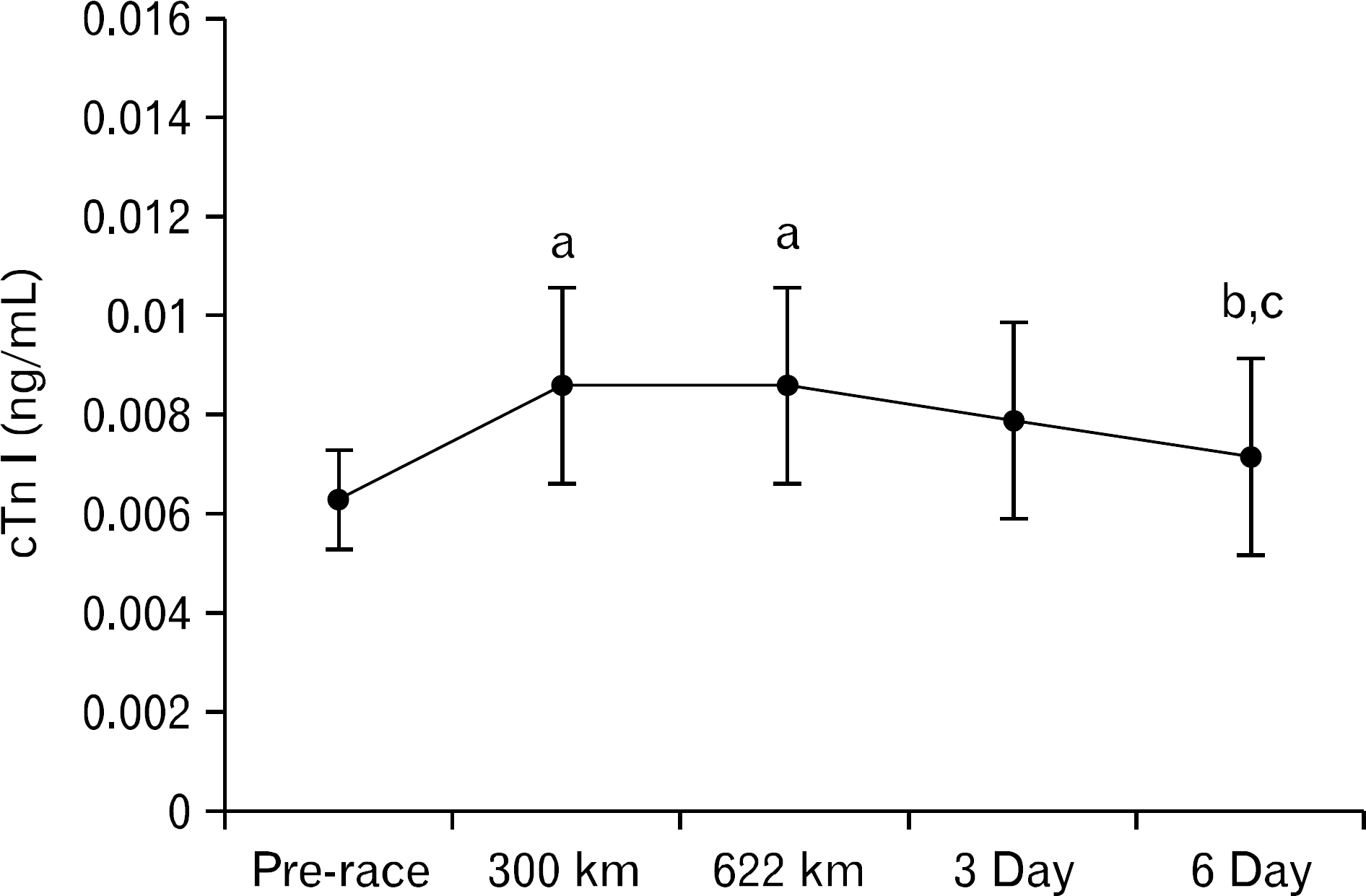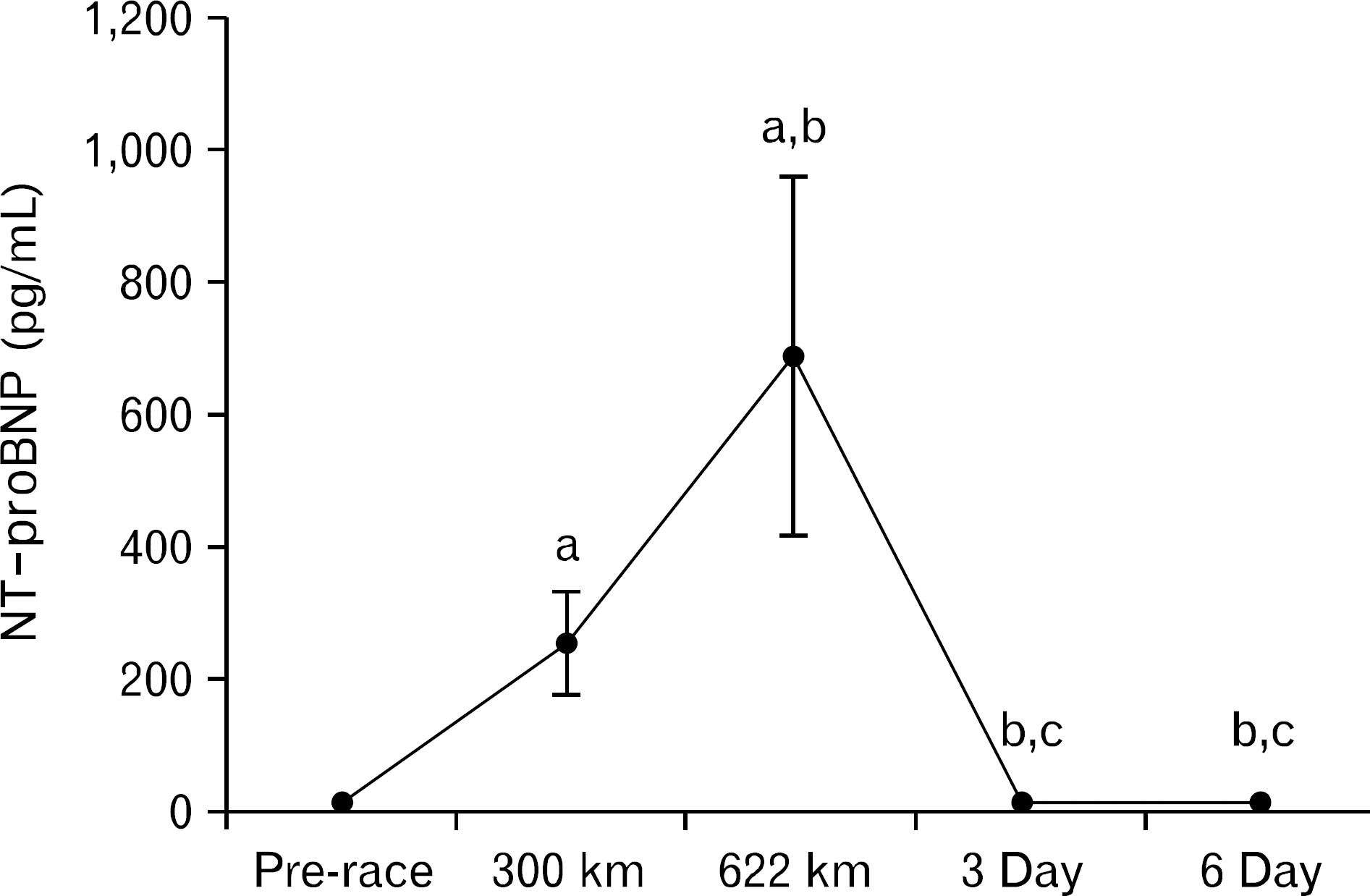Korean J Sports Med.
2018 Sep;36(3):135-142. 10.5763/kjsm.2018.36.3.135.
Effects of Super-Ultramarathon Races (622 km) on Cardiac Bio-Markers and Markers of Muscle Damage
- Affiliations
-
- 1Department of Clinical Laboratory Science, Shinsung University, Dangjin, Korea.
- 2Department of Rehabilitation Medicine, Sanggye-Paik Hospital, Inje University College of Medicine, Seoul, Korea.
- 3Department of Exercise Rehabilitation Welfare, Soojung Campus, Sungshin University, Seoul, Korea. kyj87@sungshin.ac.kr
- KMID: 2429211
- DOI: http://doi.org/10.5763/kjsm.2018.36.3.135
Abstract
- PURPOSE
Changes in serum biomarkers of cardiac and muscle damage have been studied in ultra-marathon runners for distances up to 308 km. We investigated these biomarker changes following a 622-km super-ultramarathon race.
METHODS
A group of men with a mean age of 52.7±4.8 years participated. Blood samples were obtained pre-race, during the race, and post-race, to analyze the aforementioned biomarkers.
RESULTS
Creatine kinase and creatine kinase-MB (CK-MB) levels increased during the race, and both steadily declined post-race with CK-MB declining at a slower rate. Lactic acid dehydrogenase levels overall were increased over pre-race levels. White blood cell counts increased during the race. Red blood cell decreased from pre-race to 300 km and 622 km. Platelet increased only in the recovery period. High-sensitivity C-reactive protein levels were increased throughout the race and at day 3 compared to pre-race levels. Cardiac troponin I (cTnI) levels increased during the race. N-terminal pro b-type natriuretic peptide (NT-proBNP) levels increased during the race.
CONCLUSION
The rise in cTnI was not clinically significant, and highly elevated NT-proBNP levels during the race indicates that myocardial burden rose linearly as running distance increased. However, no clinical risk was found as most of the markers returned to normal range during the recovery.
MeSH Terms
-
Biomarkers
Blood Platelets
C-Reactive Protein
Continental Population Groups*
Creatine
Creatine Kinase
Erythrocytes
Humans
Lactic Acid
Leukocyte Count
Male
Natriuretic Peptide, Brain
Oxidoreductases
Reference Values
Rhabdomyolysis
Running
Troponin I
Biomarkers
C-Reactive Protein
Creatine
Creatine Kinase
Lactic Acid
Natriuretic Peptide, Brain
Oxidoreductases
Troponin I
Figure
Reference
-
1. Fortescue EB, Shin AY, Greenes DS, et al. Cardiac troponin increases among runners in the Boston Marathon. Ann Emerg Med. 2007; 49:137–43. .e1.
Article2. Sedaghat-Hamedani F, Kayvanpour E, Frankenstein L, et al. Biomarker changes after strenuous exercise can mimic pulmonary embolism and cardiac injury: a metaanalysis of 45 studies. Clin Chem. 2015; 61:1246–55.3. Herrmann M, Scharhag J, Miclea M, Urhausen A, Herrmann W, Kindermann W. Post-race kinetics of cardiac troponin T and I and N-terminal pro-brain natriuretic peptide in marathon runners. Clin Chem. 2003; 49:831–4.
Article4. Clarkson PM. Exertional rhabdomyolysis and acute renal failure in marathon runners. Sports Med. 2007; 37:361–3.
Article5. Scharhag J, George K, Shave R, Urhausen A, Kindermann W. Exercise-associated increases in cardiac biomarkers. Med Sci Sports Exerc. 2008; 40:1408–15.
Article6. Legaz-Arrese A, George K, Carranza-Garcia LE, Munguia-Izquierdo D, Moros-Garcia T, Serrano-Ostariz E. The impact of exercise intensity on the release of cardiac biomarkers in marathon runners. Eur J Appl Physiol. 2011; 111:2961–7.
Article7. Serrano-Ostariz E, Legaz-Arrese A, Terreros-Blanco JL, et al. Cardiac biomarkers and exercise duration and intensity during a cycle-touring event. Clin J Sport Med. 2009; 19:293–9.8. Serrano-Ostariz E, Terreros-Blanco JL, Legaz-Arrese A, et al. The impact of exercise duration and intensity on the release of cardiac biomarkers. Scand J Med Sci Sports. 2011; 21:244–9.9. Yoon JH, Park Y, Ahn J, Shin KA, Kim YJ. Changes in the markers of cardiac damage in men following long-distance and ultra-long-distance running races. J Sports Med Phys Fitness. 2016; 56:295–301.10. Scharhag J, Herrmann M, Urhausen A, Haschke M, Herrmann W, Kindermann W. Independent elevations of N-terminal pro-brain natriuretic peptide and cardiac troponins in endurance athletes after prolonged strenuous exercise. Am Heart J. 2005; 150:1128–34.
Article11. Scott JM, Esch BT, Shave R, Warburton DE, Gaze D, George K. Cardiovascular consequences of completing a 160-km ultra-marathon. Med Sci Sports Exerc. 2009; 41:26–34.
Article12. Roth HJ, Leithauser RM, Doppelmayr H, et al. Cardio-specificity of the 3rd generation cardiac troponin T assay during and after a 216 km ultra-endurance marathon run in Death Valley. Clin Res Cardiol. 2007; 96:359–64.
Article13. Bartzeliotou AI, Margeli AP, Tsironi M, et al. Circulating levels of adhesion molecules and markers of endothelial activation in acute inflammation induced by prolonged brisk exercise. Clin Biochem. 2007; 40:765–70.
Article14. Kim YJ, Shin YO, Lee JB, et al. The effects of running a 308 km ultra-marathon on cardiac markers. Eur J Sport Sci. 2014; 14(Suppl 1):S92–7.
Article15. Dill DB, Costill DL. Calculation of percentage changes in volumes of blood, plasma, and red cells in dehydration. J Appl Physiol. 1974; 37:247–8.
Article16. Wu HJ, Chen KT, Shee BW, Chang HC, Huang YJ, Yang RS. Effects of 24 h ultra-marathon on biochemical and hematological parameters. World J Gastroenterol. 2004; 10:2711–4.
Article17. Warhol MJ, Siegel AJ, Evans WJ, Silverman LM. Skeletal muscle injury and repair in marathon runners after competition. Am J Pathol. 1985; 118:331–9.18. Ridker PM, Hennekens CH, Buring JE, Rifai N. C-reactive protein and other markers of inflammation in the prediction of cardiovascular disease in women. N Engl J Med. 2000; 342:836–43.
Article19. Heber S, Volf I. Effects of physical (in)activity on platelet function. Biomed Res Int. 2015; 2015:165078.
Article20. Kim HJ, Lee YH, Kim CK. Biomarkers of muscle and cartilage damage and inflammation during a 200 km run. Eur J Appl Physiol. 2007; 99:443–7.21. Kobayashi Y, Takeuchi T, Hosoi T, Yoshizaki H, Loeppky JA. Effect of a marathon run on serum lipoproteins, creatine kinase, and lactate dehydrogenase in recreational runners. Res Q Exerc Sport. 2005; 76:450–5.
Article22. Rose LI, Bousser JE, Cooper KH. Serum enzymes after marathon running. J Appl Physiol. 1970; 29:355–7.
Article23. Milne CJ. Rhabdomyolysis, myoglobinuria and exercise. Sports Med. 1988; 6:93–106.
Article24. Pearson JR, Carrea F. Evaluation of the clinical usefulness of a chemiluminometric method for measuring creatine kinase MB. Clin Chem. 1990; 36:1809–11.
Article25. Thygesen K, Alpert JS, White HD. Joint ESC/ACCF/AHA/WHF Task Force for the Redefinition of Myocardial Infarction. Universal definition of myocardial infarction. Eur Heart J. 2007; 28:2525–38.26. Shave R, Baggish A, George K, et al. Exercise-induced cardiac troponin elevation: evidence, mechanisms, and implications. J Am Coll Cardiol. 2010; 56:169–76.27. Kim YJ, Shin YO, Lee YH, et al. Effects of marathon running on cardiac markers and endothelin-1 in EIH athletes. Int J Sports Med. 2013; 34:777–82.
Article28. Nie J, Close G, George KP, Tong TK, Shi Q. Temporal association of elevations in serum cardiac troponin T and myocardial oxidative stress after prolonged exercise in rats. Eur J Appl Physiol. 2010; 110:1299–303.
Article29. Omland T, de Lemos JA, Morrow DA, et al. Prognostic value of N-terminal pro-atrial and pro-brain natriuretic peptide in patients with acute coronary syndromes. Am J Cardiol. 2002; 89:463–5.
Article
- Full Text Links
- Actions
-
Cited
- CITED
-
- Close
- Share
- Similar articles
-
- Effects of Super-ultramarathon Running on Cardiac Structure and Function in Middle-aged Men
- Comparison of Changes in Glucose and Lipid Parameters Associated with Three Types of Long-Distance Running
- Effects of Long-Distance Running on Cardiac Markers and Biomarkers in Exercise-Induced Hypertension Runners: An Observational Study
- Using CT to Evaluate Cardiac Function
- Bio-Molecular Markers for Cardiovascular Disease: Significance of Natriuretic Peptides and Adrenomedullin



